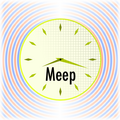Casimir calculations in Meep
From AbInitio
(Difference between revisions)
| Revision as of 18:48, 3 April 2009 (edit) Alexrod7 (Talk | contribs) (→Introduction) ← Previous diff |
Revision as of 18:49, 3 April 2009 (edit) Alexrod7 (Talk | contribs) (→Introduction) Next diff → |
||
| Line 14: | Line 14: | ||
| ==Introduction== | ==Introduction== | ||
| - | In this section, we introduce the equations and basic considerations | + | To do |
| - | involved in computing the force using the method presented in | + | |
| - | [refs]. Note that we keep the details of the derivation to a minimum | + | |
| - | and instead focus on the calculational aspects of the resulting | + | |
| - | algorithm. | + | |
| - | + | ||
| - | The basic steps involved in computing the Casimir force, as outlined | + | |
| - | in [ref], are: | + | |
| - | + | ||
| - | 1. Map the problem onto a new problem with dissipation. Here, as in | + | |
| - | [ref], we choose a frequency-independent conductivity "sigma". | + | |
| - | + | ||
| - | 2. Measure the electric '''E''' and magnetic '''H''' fields in response to | + | |
| - | current pulses placed separately at each point along a surface | + | |
| - | enclosing the body of interest. | + | |
| - | + | ||
| - | 3. Integrate these fields in spave over the enclosing surface and then | + | |
| - | integrate this result, multiplied by a known function <math>g(-t)</math>, over | + | |
| - | time t. | + | |
| - | + | ||
| - | [The manner in which (1) and (2) are performed plays a large role on | + | |
| - | the efficiency of the method. For example, computing the fields due to | + | |
| - | ach source separately at each point on the surface, as described in | + | |
| - | (2), would require a separate Meep calculation for each source (and | + | |
| - | polarization). As described in [ref], and further below, it is | + | |
| - | possible to modify the calculation of these steps so as to optimize | + | |
| - | the calculation of the stress tensor over the spatial surface. For the | + | |
| - | purpose of this introduction, however, we do not require specific | + | |
| - | details on how we handle the spatial integration.] | + | |
| ==Parallel plates== | ==Parallel plates== | ||
Revision as of 18:49, 3 April 2009
| Meep |
| Download |
| Release notes |
| FAQ |
| Meep manual |
| Introduction |
| Installation |
| Tutorial |
| Reference |
| C++ Tutorial |
| C++ Reference |
| Acknowledgements |
| License and Copyright |
Casimir calculations in Meep
It is possible to use the Meep time-domain simulation code in order to calculate Casimir forces (and related quantities), a quantum-mechanical force that can arise even between neutral bodies due to quantum vacuum fluctuations in the electromagnetic field, or equivalently as a result of geometry dependence in the quantum vacuum energy.
Calculating Casimir forces in a classical time-domain Maxwell simulation like Meep is possible because of a new algorithm described in:
- Alejandro W. Rodriguez, Alexander P. McCauley, John D. Joannopoulos, and Steven G. Johnson, "Casimir forces in the time domain: I. Theory," arXiv preprint archive article arXiv:0904.0267 (April 2009).
- Alexander P. McCauley, Alejandro W. Rodriguez, John D. Joannopoulos, and Steven G. Johnson, "Casimir forces in the time domain: II. Applications," manuscript in preparation (2009).
This page will provide some tutorial examples showing how these calculations are performed for simple geometries.
Introduction
To do
Parallel plates
To do.

